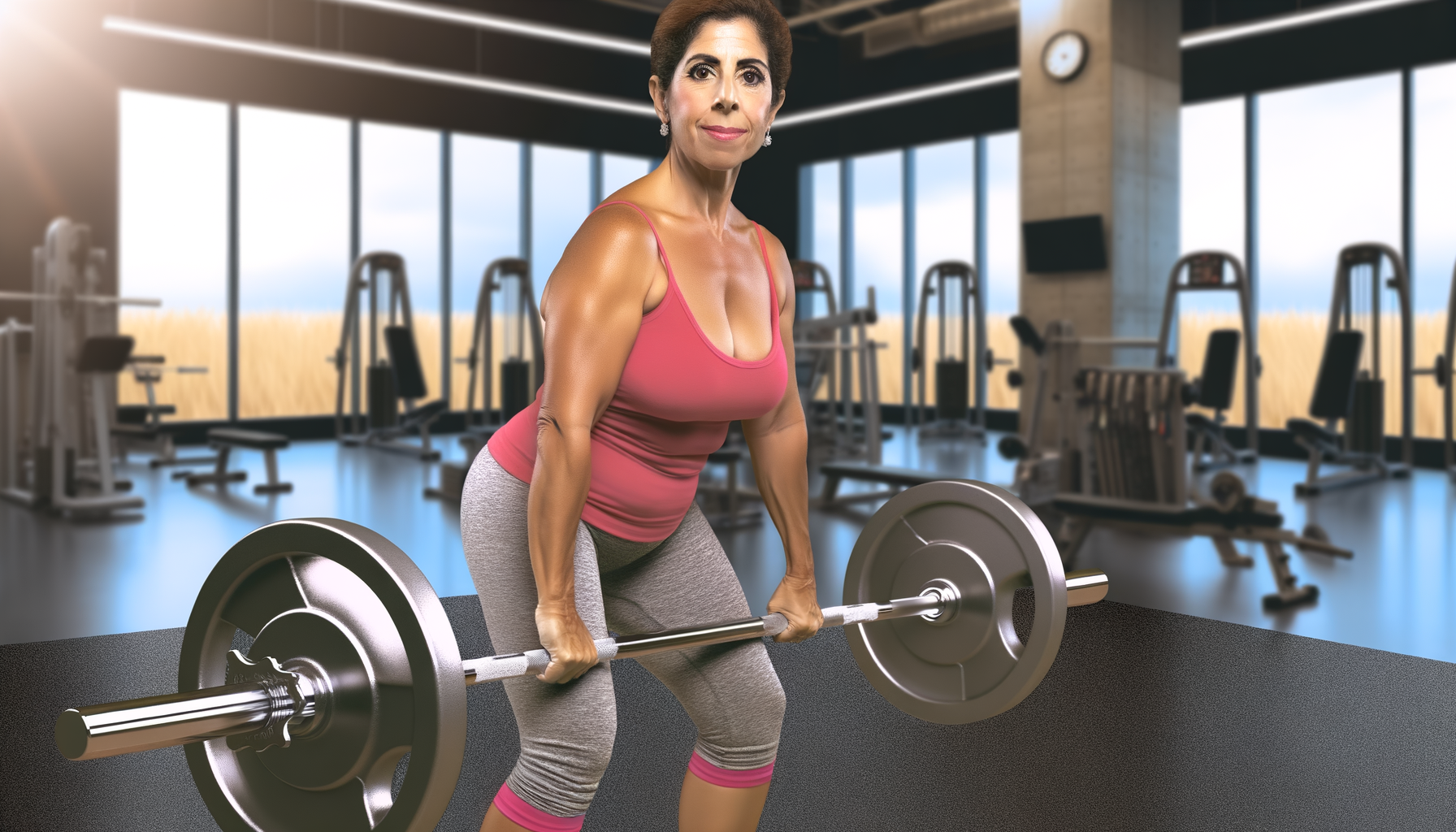Menopause and Strength Training
Menopause marks a significant transition in a woman’s life, typically occurring in the late 40s to early 50s. It is defined as the cessation of menstruation for twelve consecutive months and signifies the end of reproductive capability. This natural biological process is accompanied by a decline in estrogen and progesterone production from the ovaries, leading to various physiological changes. These changes can impact health, manifesting as vasomotor symptoms (hot flashes, night sweats), sleep disturbances, mood swings, and increased risks for osteoporosis, cardiovascular disease, and metabolic syndrome. Understanding these changes is crucial for managing health during and after the menopausal transition.
The Importance of Muscle Stimulation During Menopause
As estrogen levels drop during menopause, women face an increased risk of sarcopenia, the loss of muscle mass and strength. This decline in muscle health can lead to a slower metabolism, weight gain, and a decrease in functional capacity, exacerbating the risk of falls and fractures. Engaging in regular strength training, or resistance exercise, is essential for stimulating muscle growth and maintenance. This form of exercise not only helps in preserving muscle mass but also contributes to improved metabolic health, bone density, and overall quality of life during menopause.
Common Misconceptions About Weight Lifting for Menopausal Women
Despite the benefits, there are misconceptions that deter menopausal women from lifting heavy weights. One common myth is that weight lifting is unsuitable for older women due to the risk of injury. However, with proper guidance and technique, strength training can be safe and highly beneficial. Another misconception is that lifting weights will lead to a bulky physique. In reality, due to hormonal changes, it is challenging for menopausal women to gain large muscle mass; instead, they are likely to achieve a toned and lean body composition. Dispelling these myths is crucial to encourage more women to incorporate strength training into their fitness routines.
The Science of Muscle-Building Stem Cells
Role of Estrogen in Muscle Regeneration
Estrogen, a hormone prevalent in women before menopause, plays a critical role in muscle health and regeneration. It influences the activity of muscle stem cells, known as satellite cells, which are essential for muscle repair and growth. Estrogen enhances the proliferation and survival of these cells, thereby facilitating muscle regeneration. As women approach menopause, estrogen levels decline, leading to a decrease in the regenerative capacity of muscle tissue. This hormonal shift can result in a loss of muscle mass and strength, making resistance training an important intervention for maintaining muscle integrity during and after the menopausal transition.
How Resistance Training Stimulates Muscle-Making Cells
Resistance training, or lifting heavy weights, is a potent stimulus for muscle growth. It activates satellite cells, which are dormant muscle-building stem cells that reside on the periphery of muscle fibers. When muscles are subjected to the stress of heavy lifting, these cells spring into action, multiplying and fusing with existing muscle fibers to repair damage and build new muscle tissue. This process, known as hypertrophy, leads to stronger, larger muscles. For menopausal women, engaging in resistance training can help counteract the natural decline in muscle-making cell activity, preserving muscle mass and function.
The Decline of Satellite Cells During Menopause
During menopause, the natural decline in estrogen levels is associated with a reduction in the number and function of satellite cells. This decline can lead to a decrease in muscle regenerative capacity and a loss of muscle mass, known as sarcopenia. Sarcopenia can have profound effects on a woman’s metabolic health, physical function, and overall quality of life. By incorporating heavy resistance training into their fitness regimen, menopausal women can stimulate their satellite cells, promoting muscle maintenance and growth despite the hormonal changes that accompany menopause.
In summary, the interplay between estrogen, satellite cells, and resistance training is crucial for muscle health in menopausal women. While the menopausal transition poses challenges to muscle regeneration due to hormonal fluctuations, resistance training offers a powerful countermeasure. By lifting heavy weights, menopausal women can stimulate their muscle-making cells, helping to maintain muscle mass, enhance metabolism, and support overall health and well-being.
Metabolic Advantages of Lifting Heavy Weights
Muscle Mass and Its Effect on Metabolism
As women enter menopause, they often experience a decline in muscle mass, which can lead to a slower metabolism. This is because muscle tissue is metabolically active and burns calories even at rest. Lifting heavy weights is one of the most effective ways to maintain and build muscle mass, which in turn can help to counteract the metabolic slowdown that accompanies menopause. The process of muscle hypertrophy, which occurs as a response to resistance training, not only enhances strength but also increases the body’s resting metabolic rate (RMR), leading to greater energy expenditure throughout the day.
Comparative Study of Energy Expenditure in Menopausal Women
A study published in the American Journal of Physiology—Endocrinology and Metabolism found that postmenopausal women burned 19 percent less energy during a 45-minute cycling test compared to premenopausal women. However, when accounting for differences in lean body mass, the disparity in calories burned disappeared. This suggests that the decline in metabolism often seen in menopausal women is largely due to decreased muscle mass rather than age itself. Therefore, incorporating heavy resistance training to maintain or increase muscle mass is crucial for sustaining a higher metabolic rate during menopause.
Lean Body Mass as a Metabolic Game Changer
Lean body mass (LBM) is a significant factor in determining an individual’s metabolic rate. A higher proportion of LBM translates to a higher RMR, meaning more calories are burned at rest. For menopausal women, maintaining or increasing LBM through lifting heavy weights can be a metabolic game changer. It not only helps in managing weight but also improves overall body composition by reducing fat mass and increasing muscle mass. This shift in body composition is essential for menopausal women as it helps in countering the effects of a slowing metabolism and aids in the prevention of weight gain, which is common during this stage of life.
Bone Density and Heavy Resistance Training
The Risk of Bone Loss During Menopause
Menopause marks a significant transition in a woman’s life, not only hormonally but also in terms of bone health. During this period, the decline in estrogen levels can lead to a decrease in bone density, making bones more fragile and susceptible to fractures. In fact, up to 20 percent of a woman’s lifetime bone loss can occur in the years following menopause. This accelerated bone loss can increase the risk of osteoporosis, a condition characterized by porous and weak bones.
How Heavy Lifting Strengthens Bones
Engaging in heavy resistance training, or lifting heavy weights, can be a powerful countermeasure against bone density loss. When muscles exert force on bones during weight lifting, it stimulates bone formation and slows down bone loss. This process, known as mechanotransduction, involves the conversion of mechanical stress into biological signals that promote bone remodeling and strengthening. Heavy lifting, particularly exercises like deadlifts, squats, and lunges, applies the kind of stress needed to trigger these beneficial changes in bone structure.
Preventive Measures Against Osteoporosis
To prevent the onset of osteoporosis, menopausal women should consider incorporating heavy resistance training into their fitness regimen. The following strategies can help maximize the bone-strengthening benefits of weight lifting:
- Consistency: Regularly scheduled sessions, ideally two to three times per week, can help maintain and build bone density.
- Progressive Overload: Gradually increasing the weight lifted ensures continuous adaptation and bone strengthening.
- Focus on Compound Movements: Exercises that engage multiple joints and muscle groups are most effective for bone health.
- Supervision and Safety: Working with a qualified trainer can ensure proper form and technique, reducing the risk of injury.
- Nutrition: Adequate intake of calcium and vitamin D supports bone health, complementing the benefits of resistance training.
By adopting these measures, menopausal women can significantly reduce their risk of osteoporosis and enjoy a stronger, more resilient skeletal system.

From unhappy, dry, and sandpaper to silky, smooth and feeling good. That’s Cleo. Cleo is a 100% natural labial balm to moisture and soothe “your other lips”. Cleo is chemical-free, water-free, pH optimized and helps maintain and restore your delicate labial skin’s natural flora. Ideal for daily use or as needed. Get the most silky, lovable lips ever.
Cardiovascular and General Health Benefits
Improvements in Insulin Sensitivity and Blood Pressure
Lifting heavy weights is not just about building muscle; it’s also about bolstering your health, particularly your cardiovascular system. Menopausal women can experience significant improvements in insulin sensitivity and blood pressure through regular resistance training. Insulin sensitivity is crucial because it helps regulate blood sugar levels, reducing the risk of type 2 diabetes—a condition that women are more susceptible to post-menopause. Additionally, strength training can lead to lower blood pressure readings, which is vital in preventing hypertension and reducing the strain on the heart and arteries.
Reduction of Visceral Fat and Enhanced Immunity
Another compelling reason for menopausal women to engage in heavy lifting is the reduction of visceral fat. This type of fat surrounds the organs and is linked to numerous health issues, including heart disease and diabetes. Heavy resistance training has been shown to combat this dangerous fat more effectively than cardiovascular exercises alone. Moreover, a leaner body composition contributes to enhanced immunity. As muscle mass increases and body fat decreases, the body becomes more efficient at regulating inflammation and protecting against illness.
Overall Health Gains from Resistance Training
The overarching benefits of resistance training extend to general health improvements that can significantly enhance the quality of life for menopausal women. By incorporating heavy lifting into their fitness regimen, women can enjoy a host of advantages such as better joint health, improved mental health, and increased longevity. The act of lifting heavy weights challenges the body in a way that promotes overall systemic health, making it a powerful tool in the management of menopausal symptoms and the prevention of age-related health decline.
Menopausal women should consider heavy resistance training as a multifaceted approach to health that offers more than just physical strength. It’s a proactive measure to improve metabolic health, combat dangerous fat deposits, and promote a robust immune system, all of which contribute to a healthier, more vibrant life during and after the transition into menopause.
Practical “Lifting Heavy Weights” Tips for Menopausal Women
Focusing on Big Lifts: Deadlifts, Squats, and Lunges
For menopausal women, incorporating big lifts such as deadlifts, squats, and lunges into their strength training routine is essential. These compound movements engage multiple muscle groups, leading to more significant strength gains and calorie burn. Deadlifts target the posterior chain, squats engage the core and lower body, and lunges focus on leg and hip strength. Together, they provide a comprehensive workout that can help counteract the muscle loss and bone density reduction associated with menopause.
Recommended Sets, Reps, and Rest Periods
When starting with heavy lifting, it’s crucial to find the right balance in your workout routine. A general guideline for menopausal women is to aim for 3-5 sets of each exercise with 5-8 repetitions per set. This rep range is optimal for building strength and muscle without overtaxing the body. Rest periods between sets should be around 60-90 seconds, allowing for sufficient recovery while maintaining workout intensity.
The Importance of Proper Form and Technique
Proper form and technique are non-negotiable when lifting heavy weights. Incorrect form can lead to injuries and diminish the effectiveness of your workout. Focus on maintaining a neutral spine, engaging your core, and moving through a full range of motion. It’s beneficial to start with lighter weights to master the form before progressively increasing the load.
Progression Strategies for Beginners
Beginners should start with a weight that challenges them while still allowing them to complete all reps with good form. Progressive overload is key; gradually increase the weight, frequency, or number of reps as your strength improves. This approach ensures continuous improvement and helps avoid plateaus.
Seeking Professional Guidance for Injury Prevention
Working with a fitness professional can provide personalized guidance and help prevent injuries. A certified trainer can assess your form, suggest modifications, and develop a tailored program that aligns with your fitness level and goals. They can also provide support and motivation, which are invaluable for maintaining a consistent exercise routine.
By focusing on these practical tips, menopausal women can safely and effectively incorporate heavy lifting into their fitness regimen, leading to improved strength, bone density, and overall health.
By the way, something for you, a little gift!!!
I am just in the middle of publishing my book. It’s about How women can balance their hormones. One part is about food and diet, of course.
Follow this link and enter your email.
I will send you this part of the book for free once the book is published. It has many concrete, practical tips and recipes and will help you feel better during menopause or times of Big hormonal fluctuations.
Annette, Damiva Lead for Health & Wellness

Conclusion: Empowering Menopausal Women Through Strength Training
Summarizing the Benefits of Heavy Weight Lifting for Menopausal Women
Throughout this article, we have explored the multifaceted benefits of Lifting Heavy Weights for menopausal women. The evidence is clear: engaging in heavy resistance training can lead to significant improvements in muscle mass, metabolism, bone density, and cardiovascular health. By incorporating heavy weights into their fitness regimen, menopausal women can combat the natural decline in muscle-making cells, boost their metabolism to counteract age-related weight gain, and strengthen their bones to prevent osteoporosis. Moreover, heavy weight lifting has been shown to improve insulin sensitivity and reduce visceral fat, contributing to a lower risk of chronic diseases and enhanced immunity.
Encouraging a Paradigm Shift in Menopause Management
The traditional approach to menopause management has often emphasized medication and light physical activity, with less focus on the transformative power of strength training. It’s time for a paradigm shift that recognizes the value of heavy weight lifting in maintaining and improving health during menopause. By dispelling misconceptions that weightlifting is unsuitable for menopausal women, we can empower them to take control of their health and well-being through informed, strength-based fitness choices.
Final Thoughts on Incorporating Lifting Heavy Weights into Lifestyle
Integrating heavy weight lifing into the lifestyle of menopausal women need not be daunting. Starting with foundational lifts such as deadlifts, squats, and lunges, and progressing gradually, can pave the way for a sustainable and effective strength training routine. It is crucial to focus on proper form, appropriate sets, reps, and rest periods to maximize benefits and minimize the risk of injury. Seeking professional guidance can provide the support needed to navigate this journey safely and effectively.
In conclusion, lifting heavy weights is not just about physical strength; it’s a catalyst for overall health and empowerment. As we have seen, the benefits extend far beyond the gym, offering menopausal women a robust strategy for thriving during a transformative stage of life. It’s time to lift the weights and lift the spirits of women navigating menopause, one heavy rep at a time.











